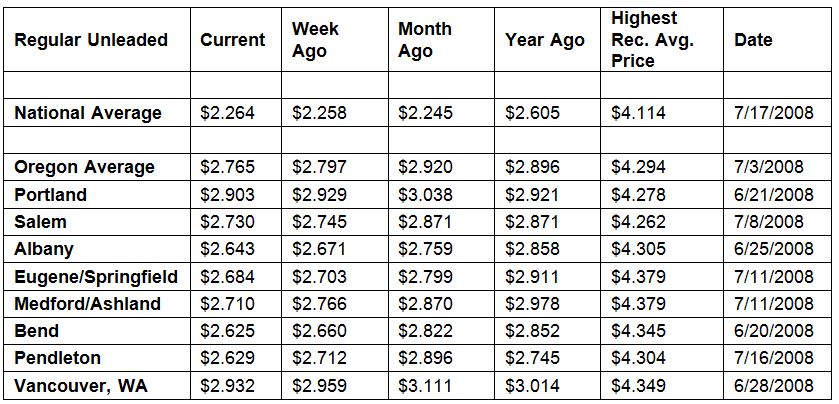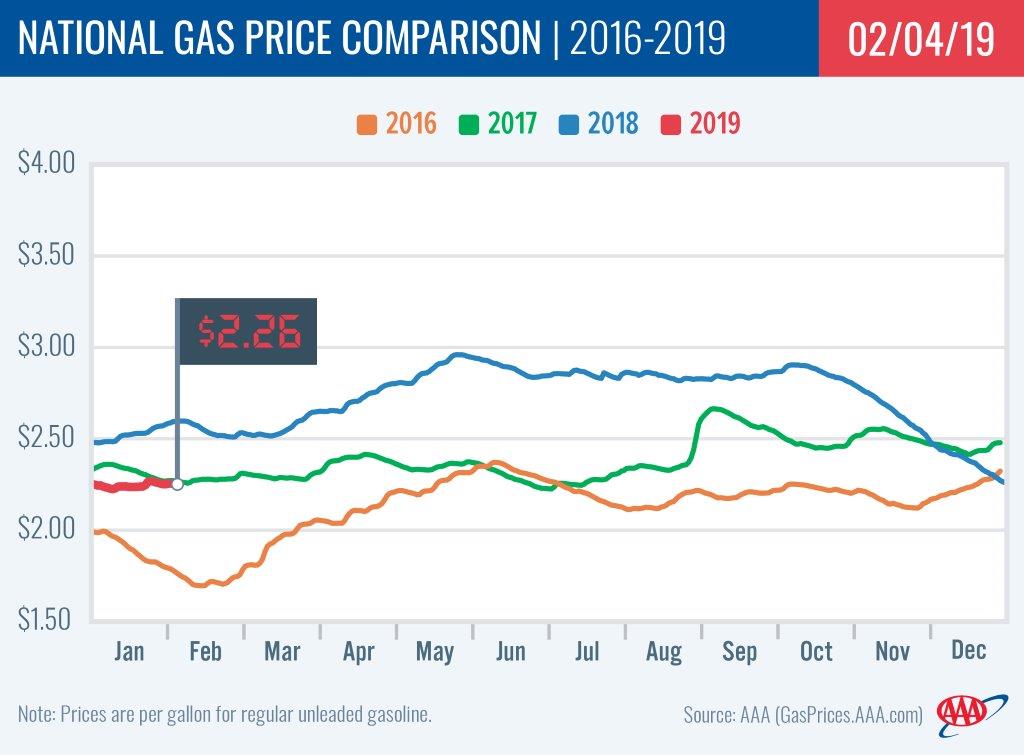PORTLAND, Ore., – Pump prices in Oregon continue to tick down while the national average is flat. U.S. demand for gas surged near summertime highs, in part due to drivers filling up ahead of last week’s record cold across much of the eastern half of the country. For the week, the national average remains at $2.26 a gallon while the Oregon average dips three cents to $2.77. This is the sixth-largest weekly drop in the nation. The Oregon average is now at its lowest price since November 2017.
The U.S. Energy Information Administration (EIA) reports U.S. gasoline demand at 9.6 million b/d for the week ending Jan 25. “The last time demand was this high was during the 2018 Labor Day weekend. One reason for the jump may be the polar vortex that brought extreme cold across the Mid West and East coast. Many drivers filled up early and often ahead of the storm. Now that temperatures are more seasonal, demand is likely to return to more normal levels for February,” says Marie Dodds, public affairs director for AAA Oregon/Idaho.
Oregon is one of 37 states and the District of Columbia where gas prices are lower week-over-week. Idaho (-6 cents) has the largest drop, followed by Utah (-5 cents). Oregon (-3 cents) has the sixth-largest weekly drop in the nation. Ohio (+14 cents) has the largest weekly increase. This week two states, Hawaii and California, have averages at or above $3 a gallon, same as a week ago.
Oregon is one of 25 states and the District of Columbia with lower prices now than a month ago. The national average is a penny more and the Oregon average is 16 cents less than a month ago. This is the seventh-largest monthly drop in the nation. Utah (-24 cents) has the largest monthly decrease. Ohio (+19 cents) has the largest month-over-month increase.
The West Coast continues to have the most expensive gas prices in the nation with all of the region’s states landing on the top 10 most expensive list. Hawaii is most expensive for the third week in a row followed by California, Washington, Alaska, Nevada and Oregon rounding out the top six. Oregon is sixth most expensive for the fifth week in a row. While still expensive, prices have mostly fallen on the week. Arizona (-4 cents) and Washington (-4 cents) have the largest drops.
| Rank | Region | Price on 2/5/19 | |
| 1 | Hawaii | $3.25 | |
| 2 | California | $3.25 | |
| 3 | Washington | $2.88 | |
| 4 | Alaska | $2.87 | |
| 5 | Nevada | $2.85 | |
| 6 | Oregon | $2.77 | |
| 7 | District of Columbia | $2.53 | |
| 8 | New York | $2.49 | |
| 9 | Pennsylvania | $2.48 | |
| 10 | Connecticut | $2.48 |
EIA’s recent weekly report showed that West Coast gasoline stocks grew by approximately 400,000 bbl to 32.8 million bbl. However, stocks are approximately 1.1 million bbl lower than at this time last year, which could cause prices to spike if there is a supply challenge in the region this week.
The nation’s cheapest markets are Missouri ($1.91) and Arkansas ($1.94). In all, nine states have averages below $2 a gallon this week up from seven states a week ago.
Oregon is one of 48 states and the District of Columbia where drivers are paying less than a year ago to fill up. The national average is 34 cents less and the Oregon average is 13 cents less than a year ago. Iowa (-56 cents) has the greatest year-over-year decrease; Nevada (+9 cents) and Arizona (+9 cents) are the only two states with year-over-year increases.
Oil Market Dynamics
Oil prices mostly increased last week, following indications of tightened global supply this year. Alongside OPEC’s production reduction agreement of 1.2 million b/d for the first six months of 2019, the recently announced U.S.-imposed crude export ban on Venezuela has made market observers worry that global crude supplies will shrink and rebalance prices. Worries over tighter supplies amid robust demand, which could dampen because of the continued trade tensions between China and the U.S., will likely continue to lift the global price of crude.
Moreover, EIA’s weekly petroleum report this week showed that total domestic crude inventories grew by 1 million bbl last week to 446 million bbl, much less than the market expected and despite crude production maintaining its record-breaking pace at 11.9 million b/d last week. Moving into this week, crude prices will likely continue their ascent, making headway for increased gasoline prices after winter.
In related news, Baker Hughes Inc. reported that the U.S. lost 15 oil rigs last week, bringing the total to 847. When compared to last year at this time, there are 82 more rigs this year.
At the close of Friday’s formal trading session on the NYMEX, WTI increased $1.47 to settle at $55.26. At the close of Monday’s formal trading session on the NYMEX, WTI lost 70 cents to settle at $54.56. Today crude is trading around $54, compared to $53 a week ago. Crude prices are up about 10 percent in the last month and are about $11 per barrel lower than a year ago.
Drivers can find current gas prices along their route with the free AAA Mobile app for iPhone, iPad and Android. The app can also be used to map a route, find discounts, book a hotel and access AAA roadside assistance. Learn more at AAA.com/mobile.
Diesel
For the week, the national average is flat at $2.92 a gallon. Oregon’s average slips a penny to $3.06. A year ago the national average for diesel was $3.00 and the Oregon average was $3.09.
Find current fuel prices at GasPrices.AAA.com.
AAA news releases, high resolution images, broadcast-quality video, fact sheets and podcasts are available on the AAA NewsRoom at NewsRoom.AAA.com.



